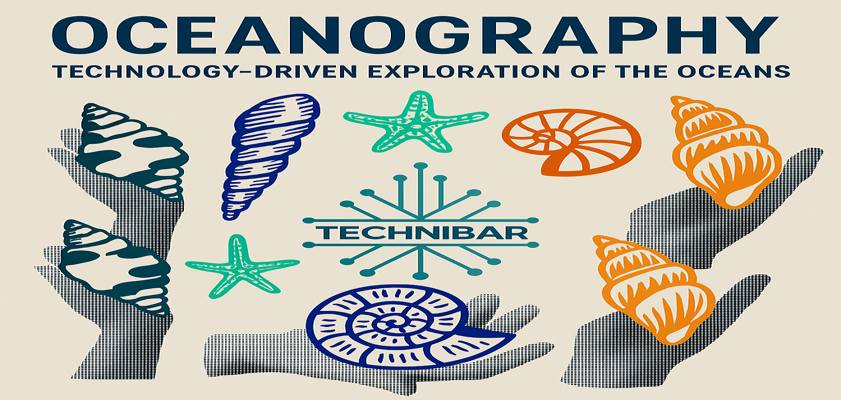The fact is that oceans, which occupy more than 70 percent of the earth surface and constitute the largest section of the world’s water, 97 percent, are not explored and humankind is unable to penetrate.To comprehend such vast marine environments, oceanography an interdisciplinary science that incorporates the disciplines of geology, biology, chemistry, physics and engineering, attempts to establish how these marine environments work. Since the first H.M.S. Challenger Expedition in 1872-1876 involving the compilation of information about oceans temperatures, ocean currents, chemistry marine life and seafloor geology, to the advanced technological equipment of modern times, the science has come a long way. World war II saw major reform in modern oceanography, as the U.S Navy funded ocean research to enhance their submarine and communication activities. Towards the end of the 1950s and 1960s submersible ships emerged, changing the way exploration took place as the underwater vehicles helped researchers reach places that were not accessible before. Sophisticated tools like buoys, water column samplers, coring tools, sonar sensors, Vehicles Operate Remotely (VOR) and autonomous platforms have today provided a fresh insight into the complexity of the ocean and its contribution towards the existence of life on earth.
Research Vessels
Scientific Vessels on the Ocean Research Vessels Floating Laboratories for Ocean Science
Oceanography cannot operate without the research vessels as stable platforms to conduct multidisciplinary research. Fleets maintained by the federal government are larger boats greater than 65 feet and are suited to both coastal and deep ocean duties. Such ships are considered as floating laboratories, and their personnel, instrumentation and even automobiles are available to receive physical, chemical and biological ocean samples.
New Research Platforms
Research class ships such as the R/V Falkor built by the Schmidt Ocean Institute undergo modern incarnation of the incorporation of developed technology. The ship is retrofitted with designs of offshore industries and it comes with:
- Numerous laboratories (main, wet, hydro, cold, seawater and electronics labs)
- VOR and robotics moon pools
- HPC systems
- A 19 meter gondola with complete ocean depth-sonars
Inclusion of satellite-based communication systems like the low Earth orbit (LEO) satellite will facilitate the transfer of ships with shore data quickly and by use of high-speed data transmission the analysis and collaboration will be possible in real-time across the entire globe. Research vessels are as well arenas to test and illustrate (nascent) marine technology, and can also rapidly spread within the scientific community.
Mechanical and Self-governing Platforms
Ocean exploration has been transformed using robotic and autonomous platforms providing researchers with a safe and ample way to reach extreme and dangerous environments which is effective as well.
VOR (Vehicles Operate Remotely)
VOR (such as VOR Sebastian), provides scientists with the capacity to make observations on site, collect delicate specimens and install experimental instruments.These systems ensure an easier comprehension of science since it offers high resolution imagery, the ability to work collaboratively in research, and long-distance participation.
Autonomous Surface and Underwater Vehicle
Uncrewed vessels (such as Saildrones and SEA-KIT vessels) increase the capacity to observe to an extent beyond manned vessels. They may be autonomous or aggregate-based and conduct varied payloads to survey the sea bed topology, sea conditions, and environmental data and biological and chemical measurements.
Swarm Technology
Swarm technology means that several autonomous systems are deployed at the same time, supporting exploration of larger scales at a time. This magnifies the utility of individual platforms and gives unparalleled resolution to collecting data on dynamics of the ocean.
Breakthroughs in the Sampling and Biological Observation
Because of technological developments, it has become immensely easier to collect fragile and not easily-studied organisms.
Precision Sampling and Life-Like Motion Soft Robotics
Soft robotics like the one, called Squishy Fingers, enables soft handling of deep-sea animals. The Rotary Actuated Dodecahedron (RAD2) ensures quick sampling of gelatinous animals in mid-water without the conventional netting, collection of intact frail specimens, which are then studied.
Non-Invasive Scanning/Observation
Three dimensions imaging, such as DeepPIV and EyeRIS uses high-resolution imagery systems that allows viewing the mid-water organisms in their natural environment. These implement taxonomic research, behavioral notes, and ecology handed-offs as they do not impact on the environment.
Sensor innovation and material science
Sensors are becoming small and parts of smart technologies are changing ocean observation.
Renewable-Powered Sensors
Solar and flexible power sources give the potential to deploy long term and with a low degree of maintenance.
Micro-Scale Sensors
Averagely-Size Sensors: Sensors modelled after nature, like maple seeds, can probe oceanic and atmospheric conditions as they fall slowly and can sample continuously over a distributed system. Innovations in material science increase longevity, versatility, and performance, thereby allowing rugged operations in extreme marine conditions that would offer long-term monitoring and climate research.
Learning Technology in the Educational Process
Ocean technology education is the training of future scientists and engineers. The objectives of experiential learning programs include engaging the students in:
- Sensor development and construction Designing and constructing sensors
- Science of running cabled underwater observatories
- Being involved in joint ventures
- Leadership and mentorship skills Development
Practical experimentation is achieved through such programs, which are a bridge between theory and practice, as well as, a conduit of interdisciplinary innovation using oceanography.
Practical Results and Successes
The subject of technological advancements has made some breakthrough discoveries:
Sea-Floor Mapping
Finding and mapping of other seamounts and coral reefs and geological features previously unknown had been found (Multibeam sonar).
Extreme Condition Research
The exploration phase was useful in that the autonomous vehicles helped to gather critical data in extreme environments, including in hurricanes and polar winters and volcanic eruptions, respective ocean-atmosphere interactions and geological processes.
High-Performance Computing
Modeling the ocean conditions in real-time and fast interpretation of sampling data can be provided by allowing off-board computational power on the vessel.
Open-Access Databases
Databases such as Fathom Net are now available where annotated imagery and biological information can be shared and international cooperation can thus be promoted.
Ocean Technology in the Future
Innovation is pegged on the future of oceanographic research.
AI Driven Autonomous Platforms
Operates enabling independent decisions with dynamic data analysis.
Robotic Avatars and Haptic Interfaces: Enable the handling in real-time of marine organisms and marine habitats at a distance.
Miniaturized and Renewable Sensors
New measurements could be placed throughout the ocean to provide extensive, renewable, and persistent measurements.
Swarm Deployments
A fleet of autonomous vehicles collaborating will allow collecting data at scale and transform the effectiveness and efficiency of research.
Through this, safer, more efficient and environmentally responsible ocean exploration will be possible and our knowledge on the world’s marine systems will be increased.
Conclusion
Oceanography has revolutionized and instruments and technologies have given researchers the ability to explore, monitor and even study marine environments in a more precise, efficient and large scale. The use of research vessels, robot platforms and technology to sample has expanded human reach to areas once too hazardous to operate in. Data collection, analysis, and dissemination is being transformed by miniaturized sensors, incorporation of AI, and renewable sources of power. Educational programmes merge these technologies with practical learning, so that the generations to come will be ready to address complicated issues in ocean science. With technological progress, the ability to investigate and know more about the oceans will also increase, thus, offering valuable data to hinge on sustainable management, environmental stewardship, and worldwide scientific cooperation.
FAQ’s
Q1. What is ocean technology?
Ocean technology is a combination of oceanography, engineering and robotics, sensors and data systems for exploration of the ocean and exploring the ocean.
Q2. What is the importance of technology in oceanography?
It allows the secure, efficient and massive data collection in remote or deep sea conditions.
Q3. What do you understand about research vessels?
Mobile laboratories, such as R/V Falkor, can be used to deploy instruments, experimentation and other autonomous vehicles.
Q4. So what is VOR?
Underwater robots Remote operated vehicles are operated in the deep sea to carry out observation and collection and experimentation.
Q5. What is the meaning of autonomous vehicles?
Autonomous submerged and surface vehicles (AUVs, Saildrones),gather information, map the seafloor topography, and detect the conditions of the ocean with no human presence on the vessels.
Q6. What is the usage of swarm technology?
A swarm of autonomous vehicles is able to survey much greater spaces effectively and collect high resolution data.
Q7. What is the process of artefacts harvesting in marine species at risk?
The presence of soft robotic manipulators and devices such as RAD2 enableIIl directional and damage-free harvesting of fragile organisms.
Q8. What are ocean research applications of AI?
AI provides the possibility of autonomous navigation, hazard detection, real-time decision-making, and ocean data analysis.
Q9. What are the haptic avatars?
Remote-controlled robotic avatars give a scientist the ability to see, touch, and manipulate an undersea object in real time.
Q10. What is happening to sensors?
The sensors used get lighter and smaller and usually solar powered allowing widespread long-term monitoring of seas.
Q11. In what ways can ocean technology be used in the study of climate?
It monitors surface conditions, ocean currents and carbon flux in order to better climate and environmental models.
Q12. What is the contribution of students in ocean technology?
Training students to design, build and run ocean sensors, Programs such as ERIS provide students with practical experience.
Q13. So what are the ocean technology discoveries?
Unprecedented coverage of the sea floor, coral reefs and sea animals, plus insight into ocean dynamics.







